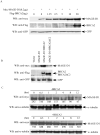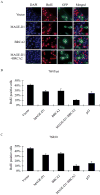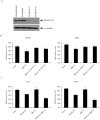BRCA2 suppresses cell proliferation via stabilizing MAGE-D1
- PMID: 15930293
- PMCID: PMC3295243
- DOI: 10.1158/0008-5472.CAN-05-0018
BRCA2 suppresses cell proliferation via stabilizing MAGE-D1
Abstract
Germ line mutations in BRCA2 gene predispose women to early-onset familial breast and ovarian cancer. BRCA2 is a protein of multiple functions. In addition to its role in DNA double-strand break repair, BRCA2 also plays a role in stabilization of stalled DNA replication forks, cytokinesis, transcription regulation, mammalian gametogenesis, centrosome duplication, and suppression of cell proliferation. However, how BRCA2 mutations predispose women specifically to breast and ovarian cancer remains undefined. Here we found that BRCA2 binds and stabilizes MAGE-D1, a member of the MAGE gene family of proteins. Expression of BRCA2 and MAGE-D1 synergistically suppresses cell proliferation independently of the p53 pathway. Using two MAGE-D1 RNA interferences and two cell lines expressing low or undetectable levels of MAGE-D1, we further showed that the expression of MAGE-D1 is required for BRCA2-mediated suppression of cell proliferation, indicating that MAGE-D1 is a downstream target of BRCA2 and that BRCA2 suppresses cell proliferation via stabilizing MAGE-D1. Importantly, MAGE-D1 protein expression was reduced in 6 of 16 breast carcinoma cell lines tested as compared with untransformed immortal mammary epithelial cell lines, suggesting that suppression of MAGE-D1 expression may be involved in the tumorigenesis of a subset of sporadic breast cancers.
Figures






Similar articles
-
Altered expression of BRCA1, BRCA2, and a newly identified BRCA2 exon 12 deletion variant in malignant human ovarian, prostate, and breast cancer cell lines.Mol Carcinog. 2000 Aug;28(4):236-46. doi: 10.1002/1098-2744(200008)28:4<236::aid-mc6>3.0.co;2-h. Mol Carcinog. 2000. PMID: 10972993
-
BRCA2 suppresses replication stress-induced mitotic and G1 abnormalities through homologous recombination.Nat Commun. 2017 Sep 13;8(1):525. doi: 10.1038/s41467-017-00634-0. Nat Commun. 2017. PMID: 28904335 Free PMC article.
-
Palb2 synergizes with Trp53 to suppress mammary tumor formation in a model of inherited breast cancer.Proc Natl Acad Sci U S A. 2013 May 21;110(21):8632-7. doi: 10.1073/pnas.1305362110. Epub 2013 May 8. Proc Natl Acad Sci U S A. 2013. PMID: 23657012 Free PMC article.
-
The BRCA2-EMSY connection: implications for breast and ovarian tumorigenesis.Cell. 2003 Nov 26;115(5):507-8. doi: 10.1016/s0092-8674(03)00933-4. Cell. 2003. PMID: 14651841 Review.
-
The cancer connection: BRCA1 and BRCA2 tumor suppression in mice and humans.Oncogene. 2002 Dec 16;21(58):8994-9007. doi: 10.1038/sj.onc.1206177. Oncogene. 2002. PMID: 12483515 Review.
Cited by
-
Loss of smarcad1a accelerates tumorigenesis of malignant peripheral nerve sheath tumors in zebrafish.Genes Chromosomes Cancer. 2021 Nov;60(11):743-761. doi: 10.1002/gcc.22983. Epub 2021 Aug 7. Genes Chromosomes Cancer. 2021. PMID: 34296799 Free PMC article.
-
Genetic and molecular bases of esophageal Cancer among Iranians: an update.Diagn Pathol. 2019 Aug 31;14(1):97. doi: 10.1186/s13000-019-0875-4. Diagn Pathol. 2019. PMID: 31470870 Free PMC article. Review.
-
Analysis of chromosomal aberration (1, 3, and 8) and association of microRNAs in uveal melanoma.Mol Vis. 2009 Oct 22;15:2146-54. Mol Vis. 2009. PMID: 19898689 Free PMC article.
-
Maged1 co-interacting with CREB through a hexapeptide repeat domain regulates learning and memory in mice.Mol Neurobiol. 2015 Feb;51(1):8-18. doi: 10.1007/s12035-014-8677-x. Epub 2014 Apr 4. Mol Neurobiol. 2015. PMID: 24700102
-
Ranking cancer drivers via betweenness-based outlier detection and random walks.BMC Bioinformatics. 2021 Feb 10;22(1):62. doi: 10.1186/s12859-021-03989-w. BMC Bioinformatics. 2021. PMID: 33568049 Free PMC article.
References
-
- Tavtigian SV, Simard J, Rommens J, et al. The complete BRCA2 gene and mutations in chromosome 13q-linked kindreds. Nat Genet. 1996;12:333–7. - PubMed
-
- Wooster R, Neuhausen SL, Mangion J, et al. Localization of a breast cancer susceptibility gene, BRCA2, to chromosome 13q12-13. Science (Wash DC) 1994;265:2088–90. - PubMed
-
- Wooster R, Bignell G, Lancaster J, et al. Identification of the breast cancer susceptibility gene BRCA2. Nature (Lond) 1995;378:789–92. - PubMed
-
- Gayther SA, Pharoah PD, Ponder BA. The genetics of inherited breast cancer. J Mammary Gland Biol Neoplasia. 1998;3:365–76. - PubMed
-
- Sharan SK, Morimatsu M, Albrecht U, et al. Embryonic lethality and radiation hypersensitivity mediated by Rad51 in mice lacking Brca2. Nature (Lond) 1997;386:804–10. - PubMed
Publication types
MeSH terms
Substances
Grants and funding
LinkOut - more resources
Full Text Sources
Molecular Biology Databases
Research Materials
Miscellaneous

